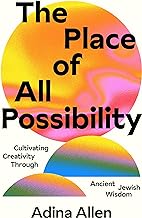The Place of All Possibility: Cultivating Creativity Through Ancient Jewish Wisdom by Adina Allen; Ayin Press, Brooklyn, NY, ©2024; ISBN 9781961-814035; 199 pages plus acknowledgements; $19.95.
By Fred Reiss, Ed.D.

 WINCHESTER, California – Parishioners generally place ordained theologians at the top of a hierarchy dispensing knowledge, wisdom, and meaning found in a religion’s holy books. Judaism is not exempt.
WINCHESTER, California – Parishioners generally place ordained theologians at the top of a hierarchy dispensing knowledge, wisdom, and meaning found in a religion’s holy books. Judaism is not exempt.
Author Adina Allen finds tension between the millennia of rabbis and scholars who create and pontificate biblical interpretations and Moses’ exhortation to the wandering Israelites that understanding Torah is not beyond anyone’s reach (Deut. 30:11-14).
Freshness, innovation, and novelty, seeing something in a new light, requires creativity, an elusive construct. Does it emerge in a few lucky people, with brains wired to synthesize disparate information? Or from a “happy brain,” diligently working on a beloved problem? Or perhaps, like a battery just sitting as potential, ready to flow with the right connections?
Allen, growing up in a home with a creative artist for a mother and bound to exchanges of interpretation and reinterpretation found in rabbinic schools, believes all are creative creatures. In her book The Place of All Possibility, she describes a method, the Jewish Studio Process, by which ordinary people extract new insights from Jewish wisdom literature, thereby gaining a deeper and more satisfying spirituality.
The Jewish Studio Process is a four-step procedure developed by Allen. It involves an active and engaging give-and-take between chavruta, learning partners, based on words found in Torah, other biblical texts, or ancient Jewish literature.
“Inquiry,” starts with a selection of text, preferably one that is personally intriguing. The chavruta read and discuss it—a vigorous sharing of thoughts and information—generating original ideas and perceptions, allowing for new possibilities to develop.
In “Intention,” each of the chavruta writes down his/her intention, “I want to explore…,” I want to experience…,” “I wish to discover what else the text can teach me.”
In “Exploration,” each of the learning partners mulls over the text and emergent ideas, letting these combinations release the creativity found in that moment; concluding with a tangible product.
Allen suggests using nontraditional modalities, such as movement, writing a story, and anything in the arts—from painting to sculpting.
“Reflection” culminates with written observations, responses, and thoughts arising from the Jewish Studio Process—the creation of a personally satisfying, and perhaps uniquely insightful conclusion drawn from the texts.
The passion Allen holds for the Jewish Studio Process is evident throughout, especially when she concludes with six case studies, examples in which texts are read, historical information made known, words examined and repeatedly dissected from different points of view, showing that just as an art studio brings intangible ideas, thoughts, and visions into the realm of the concrete, the Jewish Studio Process transforms puzzling verses or unsatisfying canonical interpretations into tangible and creative expressions, unique understandings, and deeper perceptions. It is a place well-worth exploring.
*
Fred Reiss, Ed.D. is an author whose books include The Jewish People’s Planner, A 16-Month Planner and Almanack for 5785/2024-2025 and The Comprehensive Jewish and Civil Calendars, 2001 to 2240.